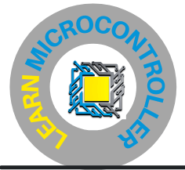So you want to learn 8051 Microcontroller? Well, that’s a great idea!
This article is about the 8051 Microcontroller Introduction with its essential features. It was developed by Intel in 1980 for use in embedded systems. At that time it was one of the most popular and most commonly used microcontrollers in various fields like embedded systems, consumer electronics, automobiles, etc.
Basically, Intel MCS-51 is commonly termed 8051 which is a single-chip microcontroller (MCU) series. This MCU has many features like Timers, Counters, Interrupts, Serial Communication, etc. If you are a beginner or student, I believe it is the easiest and best Microcontroller for you to learn the concepts of microcontrollers.

So now let’s started the journey of learning the 8051 microcontrollers with an introduction.
8051 Microcontroller Introduction
Intel’s original MCS-51 family was developed using NMOS technology, but later versions, identified by a letter C in their name (e.g., 80C51) use complementary metal–oxide–semiconductor (CMOS) technology and consume less power than their NMOS predecessors.
Originally, 8051 Microcontrollers were developed using N-MOS Technology but the use of battery-powered devices and their low power consumption lead to CMOS Technology (which is famous for its low power consumption). CMOS made 8051 more suitable for battery-powered devices.
Intel discontinued its MCS-51 product line in March 2007 but still, there are different manufacturers which are producing microcontrollers based on MCS-51. These are Atmel (AT89C51, AT89S51), Phillips (S87C654), Infineon SAB-C515, Siemens (SAB-C501), Silicon Labs (C8051), NXP (NXP700, NXP900), STC Micro (STC89C52), etc.
Now you are thinking why you should read 8051 Microcontrollers if it is old and discontinued by Intel. The reason is it is easy to learn and helps you to understand the concept of microcontrollers. Also, due to low power consumption, smaller size, and simple architecture, 8051 IP Cores are used in SoCs and FPGAs.
Applications of 8051 Microcontroller
Still, the 8051 Microcontroller is being used in many embedded systems and applications. So let’s see some applications of the 8051 Microcontroller below.
- Home Applications (Home Security Systems, TVs, VCR, Video Games, Camcorder, Music Instruments, Garage Door Openers, etc.)
- Consumer Appliances (TV Tuners, Remote controls, Computers, Sewing Machines, etc.)
- Office machines (Fax Machines, Printers), Communication Systems (Mobile Phones, Intercoms, Answering Machines, Paging Devices, etc.)
- Automobiles (Air Bags, ABS, Engine Control, Transmission Control, Temperature Control, Keyless Entry, etc)
- Aeronautical and Space
- Medical Equipment
- Defense Systems
- Robotics
- Remote Sensing
Now I believe you are familiar with the history of the 8051 microcontrollers. So now let’s see the basics of the 8051 Microcontroller.
8051 Microcontroller Basics (AT89S52)
The AT89S52 is compatible with MCS-51 Products. It is a low-power, high-performance CMOS 8-bit microcontroller with 8K bytes of in-system programmable (ISP) Flash memory. Here 8-bit means data bus of the 8051 Microcontroller (both internal and external) is 8 – bit wide. The 8051’s instruction set is designed as a Harvard architecture with segregated memory (data and instructions).
Let’s see the basic layout or block diagram of 8051 microcontroller that includes a PORT, TIMER, CPU, ROM, RAM, etc.

8051 Microcontroller Features
The AT89S52 provides the following standard features:
| Features | Quantity |
|---|---|
| Flash Memory | 8K Bytes |
| Internal RAM | 256 Bytes |
| Input/output pins | 32 |
| Timer/Counter | 3 (16-bit) |
| Full Duplex UART Serial Channel | 1 |
| Interrupt Sources | 8 |
| Operating Range | 4.0V to 5.5V |
Reference: Intel 8051
